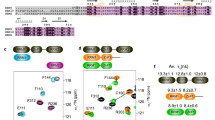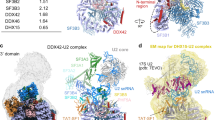Abstract
Y14 and Mago are conserved eukaryotic proteins that associate with spliced mRNAs in the nucleus and remain associated at exon junctions during and after nuclear export. In the cytoplasm, Y14 is involved in mRNA quality control via the nonsense-mediated mRNA decay (NMD) pathway and, together with Mago, is involved in localization of osk (oskar) mRNA. We have determined the crystal structure of the complex between Drosophila melanogaster Y14 and Mago at a resolution of 2.5 Å. The structure reveals an atypical mode of protein–protein recognition mediated by an RNA-binding domain (RBD). Instead of binding RNA, the RBD of Y14 engages its RNP1 and RNP2 motifs to bind Mago. Using structure-guided mutagenesis, we show that Mago is also a component of the NMD pathway, and that its association with Y14 is essential for function. Heterodimerization creates a single structural platform that interacts with the NMD machinery via phylogenetically conserved residues.
This is a preview of subscription content, access via your institution
Access options
Subscribe to this journal
Receive 12 print issues and online access
$189.00 per year
only $15.75 per issue
Buy this article
- Purchase on Springer Link
- Instant access to full article PDF
Prices may be subject to local taxes which are calculated during checkout






Similar content being viewed by others
References
Dreyfuss, G., Kim, N.V. & Kataoka, N. Messenger RNA-binding proteins and the messages they carry. Nat. Rev. Mol. Cell. Biol. 3, 195–205 (2002).
Le Hir, H., Izaurralde, E., Maquat, L.E. & Moore, M.J. The spliceosome deposits multiple proteins 20–24 nucleotides upstream of mRNA exon-exon junctions. EMBO J. 15, 6860–6869 (2000).
Wagner, E. & Lykke-Andersen, J. mRNA surveillance: the perfect persist. J. Cell Sci. 115, 3033–3038 (2002).
Le Hir, H., Gatfield, D., Izaurralde, E. & Moore, M.J. The exon-exon junction complex provides a binding platform for factors involved in mRNA export and nonsense- mediated mRNA decay. EMBO J. 20, 4987–4997 (2001).
Reichert, V.L., Le Hir, H., Jurica, M.S. & Moore, M.J. 5′ exon interactions within the human spliceosome establish a framework for exon junction complex structure and assembly. Genes Dev. 16, 2778–2791 (2002).
Kataoka, N. et al. Pre-mRNA splicing imprints mRNA in the nucleus with a novel RNA-binding protein that persists in the cytoplasm. Mol. Cell 6, 673–682 (2000).
Le Hir, H., Gatfield, D., Braun, I.C., Forler, D. & Izaurralde, E. The protein Mago provides a link between splicing and mRNA localization. EMBO Rep. 2, 1119–1124 (2001).
Lejeune, F., Ishigaki, Y., Li, X. & Maquat, L.E. The exon junction complex is detected on CBP80-bound but not eIF4E-bound mRNA in mammalian cells: dynamics of mRNP remodeling. EMBO J. 21, 3536–3545 (2002).
Dostie, J. & Dreyfuss, G. Translation is required to remove Y14 from mRNAs in the cytoplasm. Curr. Biol. 12, 1060–1067 (2002).
Zhao, X.F., Nowak, N.J., Shows, T.B. & Aplan, P.D. MAGOH interacts with a novel RNA-binding protein. Genomics 63, 145–148 (2000).
Kataoka, N., Diem, M.D., Kim, N.V., Yong, J. & Dreyfuss, G. Magoh, a human homolog of Drosophila mago nashi protein, is a component of the splicing-dependent exon-exon junction complex. EMBO J. 20, 6424–6433 (2001).
Mingot, J.M., Kostka, S., Kraft, R., Hartmann, E. & Görlich, D. Importin 13: a novel mediator of nuclear import and export. EMBO J. 20, 3685–3694 (2001).
Hachet, O. & Ephrussi, A. Drosophila Y14 shuttles to the posterior of the oocyte and is required for oskar mRNA transport. Curr. Biol. 11, 1666–1674 (2001).
Mohr, S.E., Dillon, S.T. & Boswell, R.E. The RNA-binding protein Tsunagi interacts with Magoh Nashi to establish polarity and localize oskar mRNA during Drosophila oogenesis. Genes Dev. 15, 2886–2899 (2001).
Kim, N.V., Kataoka, N. & Dreyfuss, G. Role of the nonsense-mediated decay factor Upf3 in the splicing-dependent exon-exon junction complex. Science 293, 1832–1836 (2001).
Lykke-Andersen, J., Shu, M.D. & Steitz, J.A. Communication of the position of exon-exon junctions to the mRNA surveillance machinery by the protein RNPS1. Science 293, 1836–1839 (2001).
Gehring, N.H., Neu-Yilik, G., Schell, T., Hentze, M.W. & Kulozik, A.E. Y14 and hUpf3b form an NMD-activating complex. Mol. Cell 11, 939–949 (2003).
Mickelm, D.R. et al. The mago nashi gene is required for the polarization of the oocyte and the formation of perpendicular axes in Drosophila. Curr. Biol. 7, 468–478 (1997).
Newmark, P.A., Mohr, S.E., Gong, L. & Boswell, R.E. mago nashi mediates the posterior follicle cell-to-oocyte signal to organize axis formation in Drosophila. Development 124, 3197–3207 (1997).
Burd, C.G. & Dreyfuss, G. Conserved structures and diversity of functions of RNA-binding proteins. Science 265, 615–621 (1994).
Varani, G. & Nagai, K. RNA recognition by RNP proteins during RNA processing. Annu. Rev. Biophys. Biomol. Struct. 27, 407–445 (1998).
Hall, K.B. RNA-protein interactions. Curr. Opin. Struct. Biol. 12, 283–288 (2002).
Price, S., Evan, P. & Nagai, K. Crystal structure of the spliceosomal U2B″-U2A′ protein complex bound to a fragment of U2 small nuclear RNA. Nature 394, 645–649 (1998).
Kielkopf, C.L., Rodionova, N.A., Green, M.R. & Burley, S.K. A novel peptide recognition mode revealed by the X-ray structure of a core U2AF35/U2AF65 heterodimer. Cell 106, 595–605 (2001).
Mazza, C., Segref, A., Mattaj, I.W. & Cusack, S. Large-scale induced fit recognition of an m(7)GPG cap analogue by the human nuclear cap-binding complex. EMBO J. 21, 5548–5557 (2002).
Holm, L. & Sander, C. Protein structure comparison by alignment of distance matrices. J. Mol. Biol. 233, 123–138 (1993).
Shiels, J.C., Tuite, J.B., Nolan, S.J. & Baranger, A.M. Investigation of a conserved stacking interaction in target site recognition by the U1A protein. Nucleic Acids Res. 30, 550–558 (2002).
Birney, E., Kumar, S. & Krainer, A.R. Analysis of the RNA-recognition motif and RS and RGG domains: conservation in metazoan pre-mRNA splicing factors. Nucleic Acids Res. 21, 5803–5816 (1993).
Lu, J. & Hall, K.B. Tertiary structure of RBD2 and backbone dynamics of RBD1 and RBD2 of the human U1A protein determined by NMR spectroscopy. Biochemistry 36, 10393–19405 (1997).
Rodrigues, J.P. et al. REF proteins mediate the export of spliced and unspliced mRNAs from the nucleus. Proc. Natl. Acad. Sci. USA 98, 1030–1035 (2001).
Collaborative Computational Project, Number 4. The CCP4 suite: programs for protein crystallography. Acta Crystallogr. D 50, 760–763 (1994).
Terwilliger, T.C. & Berendzen, J. Automated MAD and MIR structure solution. Acta Crystallogr. D 55, 849–861 (1999).
Terwilliger, T.C. Maximum-likelihood density modification. Acta Crystallogr. D 56, 965–972 (2000).
Jones, T.A., Zou, J.Y., Cowan, S.W. & Kjeldgaard, M. Improved methods for building protein models in electron density maps and the location of errors in these models. Acta Crystallogr. A 47, 110–119 (1991).
Brünger, A.T. et al. Crystallography & NMR system: a new software suite for macromolecular structure determination. Acta Crystallogr. D 54, 905–921 (1998).
Scherly, D. et al. Identification of the RNA binding segment of human U1 A protein and definition of its binding site on U1 snRNA. EMBO J. 8, 4163–4370 (1989).
Acknowledgements
We are grateful to beamline scientists at DESY BW7A (Hamburg), Swiss Light Source X06SA (Zurich), Elettra (Trieste) and ESRF ID14-4 and ID14-1 (Grenoble) for assistance during data collection. We thank in particular M. Polentarutti and K. Djinovic (Elettra) for help with xenon derivatization. We thank N. Gehring, A. Kulozik and M. Hentze for communicating results on the NMD reporter assay before publication, and for the gift of the reporter constructs and λN-peptide–specific antibodies. We also thank I. Mattaj, P. Brick and A. Ladurner for critical reading of the manuscript. S.F. was supported by a Marie Curie Fellowship.
Author information
Authors and Affiliations
Corresponding author
Ethics declarations
Competing interests
The authors declare no competing financial interests.
Rights and permissions
About this article
Cite this article
Fribourg, S., Gatfield, D., Izaurralde, E. et al. A novel mode of RBD-protein recognition in the Y14–Mago complex. Nat Struct Mol Biol 10, 433–439 (2003). https://doi.org/10.1038/nsb926
Received:
Accepted:
Published:
Issue Date:
DOI: https://doi.org/10.1038/nsb926
This article is cited by
-
Multifaceted roles of MAGOH Proteins
Molecular Biology Reports (2023)
-
Nonsense-mediated mRNA decay and metal ion homeostasis and detoxification in Saccharomyces cerevisiae
BioMetals (2022)
-
Exon junction complex (EJC) core genes play multiple developmental roles in Physalis floridana
Plant Molecular Biology (2018)
-
The exon junction complex factor Y14 is dynamic in the nucleus of the beetle Tribolium castaneum during late oogenesis
Molecular Cytogenetics (2017)
-
The exon junction complex as a node of post-transcriptional networks
Nature Reviews Molecular Cell Biology (2016)



